Such_Saturation
Member
- Joined
- Nov 26, 2013
- Messages
- 7,370
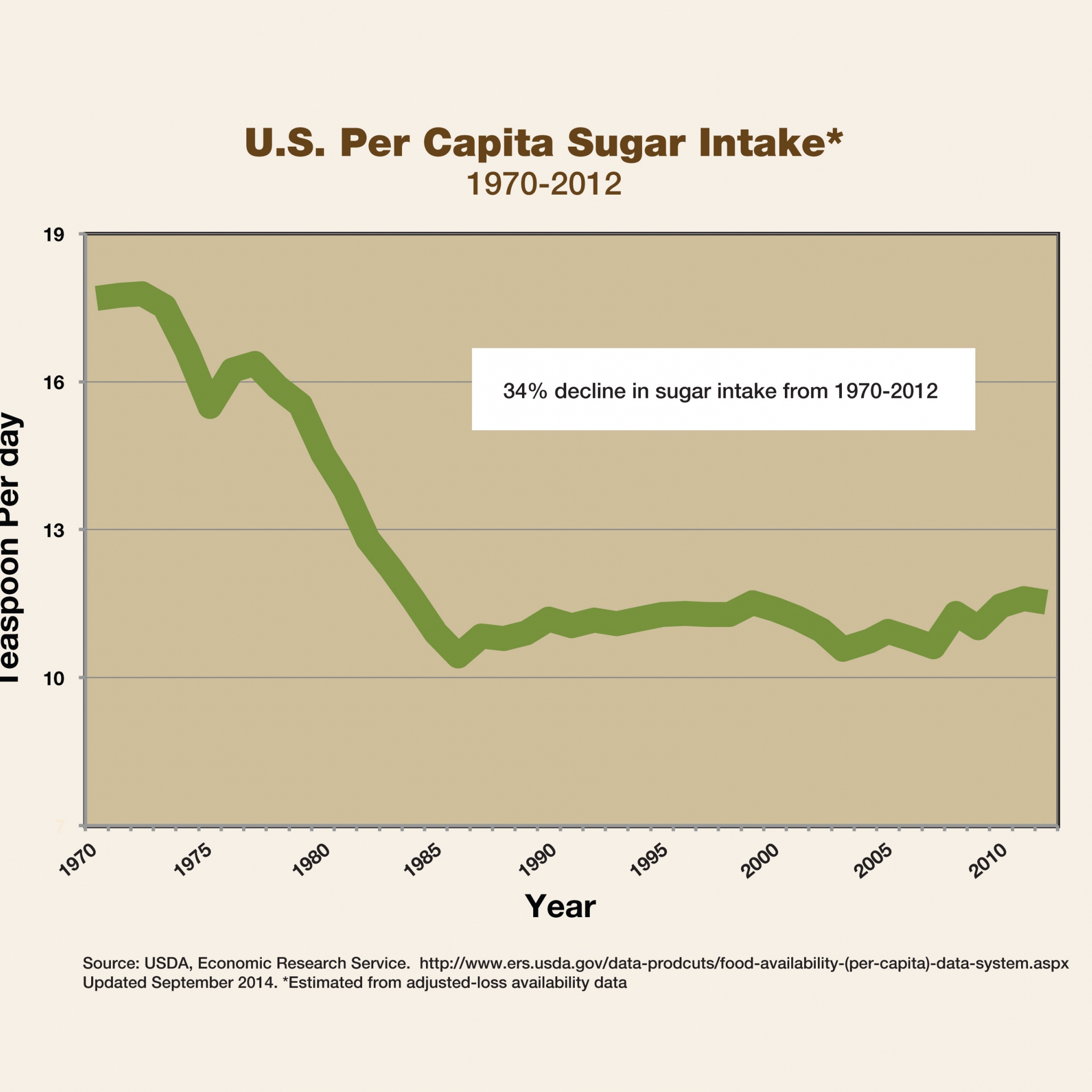
http://www.sugar.org/chart-is-sugar-consumption-trending-up-or-down/
Oh and by the way
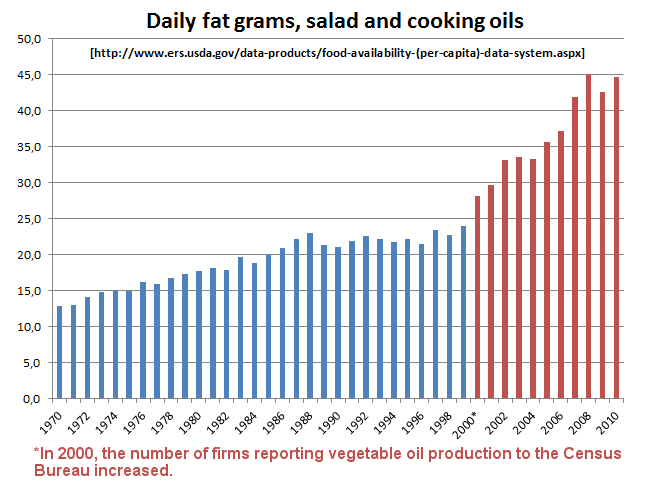
87.5% increase 1970-1999
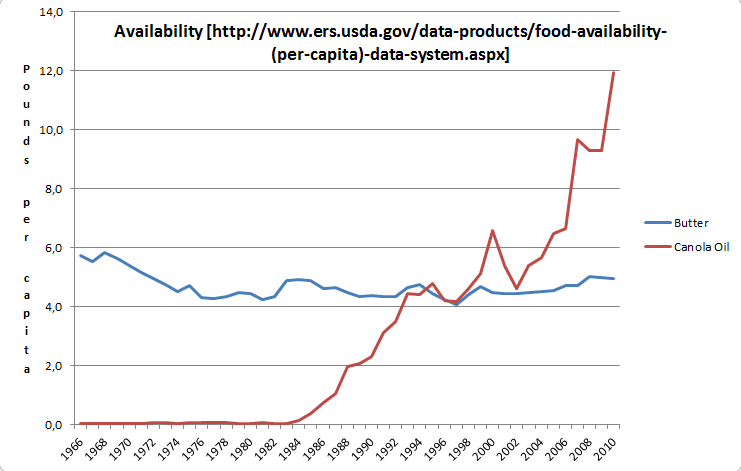
Follow along with the video below to see how to install our site as a web app on your home screen.
Note: This feature may not be available in some browsers.
Click Here if you want to upgrade your account
If you were able to post but cannot do so now, send an email to admin at raypeatforum dot com and include your username and we will fix that right up for you.



jyb said:Explosion of pufa oils since 2000? Seems like the party is just getting started then
That said, the study about sugar is dishonest. To get an idea of "pure carb" intake (as opposed to nutritious carbs), they should have looked at various syrups rather than just sucrose, as we could expect pure corn syrup or other refined products to have similar problems (or benefits) to sucrose.

Tom said:Interesting rise in canola oil. Do you have the figures for soybean oil? I think this accounts still for 2/3 of the vegetable oil intake in the US. But overall it should give a very good omega-3 to omega-6 ratio, if this is beneficial.
http://www.ers.usda.gov/topics/crops/soybeans-oil-crops/market-outlook/usda-soybean-baseline said:In the projections, soybean production declines initially (2010/11-2011/12) and then increases incrementally with a modest improvement in yields and planted acreage. The expected growth in U.S. soybean supply should allow for a moderate rise in domestic use and exports. However, exporters from South America are expected to garner most of the expansion in global trade for soybeans and soybean products, much of which will center on meeting a rapidly rising demand in China.
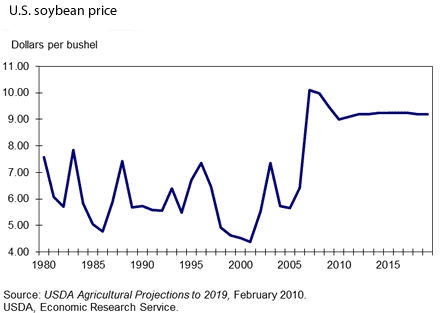
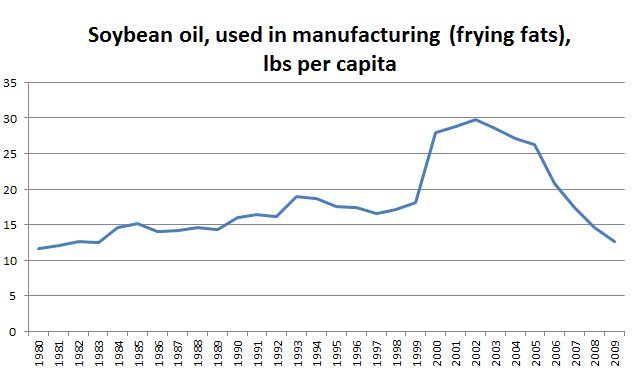
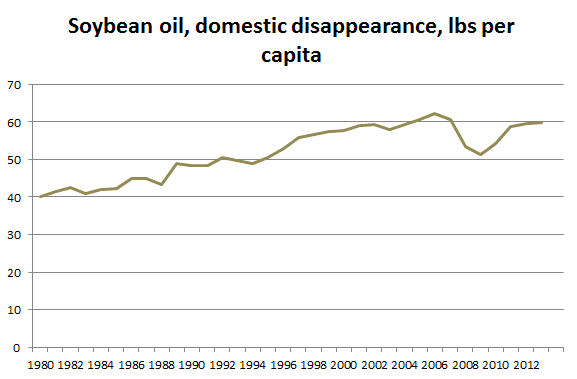
tara said:Am I reading this right? 60 lbs soybean oil per capita per year? Ie ~70g per person per day?
Wow. And for all the people who eat much less than this, there must be many who eat more. And that's just the soybean oil, not counting the canola, corn oil, etc.
Ok, that makes sense. So maybe more than half of it gets discarded as waste etc, and not so much gets eaten.Such_Saturation said:tara said:Am I reading this right? 60 lbs soybean oil per capita per year? Ie ~70g per person per day?
Wow. And for all the people who eat much less than this, there must be many who eat more. And that's just the soybean oil, not counting the canola, corn oil, etc.
I think that indicates the amount that "disappears" at the end of the year after you subtract exports, etc.
Israeli Jews eat a diet which is richer in linoleic acid (the most readily available plant-based form of omega-6 fatty acid, found in many vegetable oils), than any other population on the planet. Average per capita consumption is approximately 30 grams a day (11 kilograms annually),[1] compared to 25 grams daily for the average American in 1985.[2]
XPlus said:Very interesting.
Was looking at of photos of my family, including extended family and friends, from 60s, 70s and 80s. Wedding photos, town crowds.
Comparing these photos to how most people of similar age look now, those trends say a lot.
You bet it's not just correlation.
Tom said:Very interesting charts. But also confusing.
There is some good information on statista.com suggesting that soybean oil is still the most widely used edible oil in the US, accounting for over 60% (4 x higher than canola oil).
http://www.statista.com/statistics/3010 ... s-by-type/
On a side note, observe the much higher life expectancy in Israel than in US despite a higher linolic acid intake and poorer n6 to n3 ratio:
Israeli Jews eat a diet which is richer in linoleic acid (the most readily available plant-based form of omega-6 fatty acid, found in many vegetable oils), than any other population on the planet. Average per capita consumption is approximately 30 grams a day (11 kilograms annually),[1] compared to 25 grams daily for the average American in 1985.[2]
http://en.wikipedia.org/wiki/Israeli_paradox
jyb said:XPlus said:Very interesting.
Was looking at of photos of my family, including extended family and friends, from 60s, 70s and 80s. Wedding photos, town crowds.
Comparing these photos to how most people of similar age look now, those trends say a lot.
You bet it's not just correlation.
You only need to watch an old movie. Preferably a documentary, so the movie doesn't introduce a bias into who is in society is filmed. Then you can only be astonished by how good an average Joe looked back in the days compared to now.
Tom said:Very interesting charts. But also confusing.
There is some good information on statista.com suggesting that soybean oil is still the most widely used edible oil in the US, accounting for over 60% (4 x higher than canola oil).
http://www.statista.com/statistics/3010 ... s-by-type/
Tom said:On a side note, observe the much higher life expectancy in Israel than in US despite a higher linolic acid intake and poorer n6 to n3 ratio:
Israeli Jews eat a diet which is richer in linoleic acid (the most readily available plant-based form of omega-6 fatty acid, found in many vegetable oils), than any other population on the planet. Average per capita consumption is approximately 30 grams a day (11 kilograms annually),[1] compared to 25 grams daily for the average American in 1985.[2]
http://www.ncbi.nlm.nih.gov/pmc/articles/PMC3735464/ said:To address the potential for spurious associations to arise because of the measurement of fatty acids as proportion of total weight rather than absolute concentration (33) and to address the question of the importance of the ω-3/ω-6 ratio, long-chain ω-3 and ω-6 PUFA were included together in regression models predicting total, low-, and high-grade prostate cancer risk. Findings for total long-chain ω-3 PUFA adjusted for ω-6 PUFA were only slightly attenuated. The continuous multivariable-adjusted hazard ratios predicting total, low-, and high-grade prostate cancer risk, respectively, were 1.16 (95% CI = 0.98 to 1.36), 1.15 (95% CI = 0.97 to 1.36), and 1.40 (95% CI = 1.03 to 1.92)
http://www.ncbi.nlm.nih.gov/pmc/articles/PMC3735464/ said:Among the seven prospective studies of ω-6 PUFA (14,31,35–39,41), two reported inverse associations for LA (35,38), and, similar to our study, all others reported no associations.
Tom said:You might be able to see the charts in full if you get to the website via a google search
Tom said:You might be able to see the charts in full if you get to the website via a google search